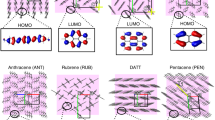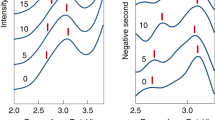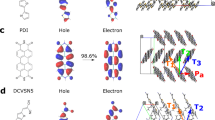Abstract
Evidence shows that charge carriers in organic semiconductors self-localize because of dynamic disorder. Nevertheless, some organic semiconductors feature reduced mobility at increasing temperature, a hallmark for delocalized band transport. Here we present the temperature-dependent mobility in two record-mobility organic semiconductors: dinaphtho[2,3-b:2′,3′-f]thieno[3,2-b]-thiophene (DNTT) and its alkylated derivative, C8-DNTT-C8. By combining terahertz photoconductivity measurements with atomistic non-adiabatic molecular dynamics simulations, we show that while both crystals display a power-law decrease of the mobility (μ) with temperature (T) following μ ∝ T −n, the exponent n differs substantially. Modelling reveals that the differences between the two chemically similar semiconductors can be traced to the delocalization of the different states that are thermally accessible by charge carriers, which in turn depends on their specific electronic band structure. The emerging picture is that of holes surfing on a dynamic manifold of vibrationally dressed extended states with a temperature-dependent mobility that provides a sensitive fingerprint for the underlying density of states.
This is a preview of subscription content, access via your institution
Access options
Access Nature and 54 other Nature Portfolio journals
Get Nature+, our best-value online-access subscription
$29.99 / 30 days
cancel any time
Subscribe to this journal
Receive 12 print issues and online access
$259.00 per year
only $21.58 per issue
Buy this article
- Purchase on Springer Link
- Instant access to full article PDF
Prices may be subject to local taxes which are calculated during checkout





Similar content being viewed by others
Data availability
The datasets generated and/or analysed during the current study are available in the Zenodo repository, https://zenodo.org/record/8109807. The full data for this study total a couple of terabytes and are in cold storage accessible by the corresponding authors and available upon reasonable request.
Code availability
The custom FOB-SH code for non-adiabatic molecular dynamics, the python code used for the DA analysis and other post-processing tools used for this study are available from the corresponding authors upon request.
References
Oberhofer, H., Reuter, K. & Blumberger, J. Charge transport in molecular materials: an assessment of computational methods. Chem. Rev. 117, 10319–10357 (2017).
Fratini, S., Mayou, D. & Ciuchi, S. The transient localization scenario for charge transport in crystalline organic materials. Adv. Funct. Mater. 26, 2292–2315 (2016).
Troisi, A. Charge transport in high mobility molecular semiconductors: classical models and new theories. Chem. Soc. Rev. 40, 2347–2358 (2011).
Giannini, S. & Blumberger, J. Charge transport in organic semiconductors: the perspective from nonadiabatic molecular dynamics. Acc. Chem. Res. 55, 819–830 (2022).
Chang, J.-F. et al. Hall-effect measurements probing the degree of charge-carrier delocalization in solution-processed crystalline molecular semiconductors. Phys. Rev. Lett. 107, 066601 (2011).
Sakanoue, T. & Sirringhaus, H. Band-like temperature dependence of mobility in a solution-processed organic semiconductor. Nat. Mater. 9, 736–740 (2010).
Marumoto, K., Kuroda, S., Takenobu, T. & Iwasa, Y. Spatial extent of wave functions of gate-induced hole carriers in pentacene field-effect devices as investigated by electron spin resonance. Phys. Rev. Lett. 97, 256603 (2006).
Matsui, H., Mishchenko, A. S. & Hasegawa, T. Distribution of localized states from fine analysis of electron spin resonance spectra in organic transistors. Phys. Rev. Lett. 104, 056602 (2010).
Tsurumi, J. et al. Coexistence of ultra-long spin relaxation time and coherent charge transport in organic single-crystal semiconductors. Nat. Phys. 13, 994–998 (2017).
Coropceanu, V. et al. Charge transport in organic semiconductors. Chem. Rev. 107, 926–952 (2007).
Karl, N. Charge carrier transport in organic semiconductors. Synth. Met. 133–134, 649–657 (2003).
Yi, H. T., Gartstein, Y. N. & Podzorov, V. Charge carrier coherence and Hall effect in organic semiconductors. Sci. Rep. 6, 23650 (2016).
Podzorov, V., Menard, E., Rogers, J. A. & Gershenson, M. E. Hall effect in the accumulation layers on the surface of organic semiconductors. Phys. Rev. Lett. 95, 226601 (2005).
Jurchescu, O. D., Baas, J. & Palstra, T. T. M. Effect of impurities on the mobility of single crystal pentacene. Appl. Phys. Lett. 84, 3061–3063 (2004).
Laarhoven, H. A. V. et al. On the mechanism of charge transport in pentacene. J. Chem. Phys. 129, 044704 (2008).
Fratini, S., Nikolka, M., Salleo, A., Schweicher, G. & Sirringhaus, H. Charge transport in high-mobility conjugated polymers and molecular semiconductors. Nat. Mater. 19, 491–502 (2020).
Fratini, S. & Ciuchi, S. Bandlike motion and mobility saturation in organic molecular semiconductors. Phys. Rev. Lett. 103, 266601 (2009).
Mott, S. N. in Sir Nevill Mott – 65 Years in Physics (eds Mott, N. F. & Alexandrov, A. S.) 657–684 (World Scientific,1995).
Ciuchi, S., Fratini, S. & Mayou, D. Transient localization in crystalline organic semiconductors. Phys. Rev. B 83, 081202 (2011).
Fratini, S., Ciuchi, S., Mayou, D., de Laissardière, G. T. & Troisi, A. A map of high-mobility molecular semiconductors. Nat. Mater. 16, 998–1002 (2017).
Nematiaram, T., Padula, D., Landi, A. & Troisi, A. On the largest possible mobility of molecular semiconductors and how to achieve it. Adv. Funct. Mater. 30, 2001906 (2020).
Nelson, T. R. et al. Non-adiabatic excited-state molecular dynamics: theory and applications for modeling photophysics in extended molecular materials. Chem. Rev. 120, 2215–2287 (2020).
Xie, W., Holub, D., Kubař, T. & Elstner, M. Performance of mixed quantum-classical approaches on modeling the crossover from hopping to bandlike charge transport in organic semiconductors. J. Chem. Theory Comput. 16, 2071–2084 (2020).
Wang, L., Qiu, J., Bai, X. & Xu, J. Surface hopping methods for nonadiabatic dynamics in extended systems. WIREs Comput. Mol. Sci. 10, e1435 (2020).
Giannini, S. et al. Quantum localization and delocalization of charge carriers in organic semiconducting crystals. Nat. Commun. 10, 3843 (2019).
Giannini, S., Carof, A., Ellis, M., Ziogos, O. G. & Blumberger, J. From atomic orbitals to nano-scale charge transport with mixed quantum/classical non-adiabatic dynamics: method, implementation and application. Ch. 6, 172–202 (2021).
Peng, B., He, Z., Chen, M. & Chan, P. K. L. Ultrahigh on‐current density of organic field‐effect transistors facilitated by molecular monolayer crystals. Adv. Funct. Mater. 32, 2202632 (2022).
Mitsui, C. et al. High-performance solution-processable N-shaped organic semiconducting materials with stabilized crystal phase. Adv. Mater. 26, 4546–4551 (2014).
Schweicher, G. et al. Chasing the ‘killer’ phonon mode for the rational design of low‐disorder, high‐mobility molecular semiconductors. Adv. Mater. 31, 1902407 (2019).
Xi, J., Long, M., Tang, L., Wang, D. & Shuai, Z. First-principles prediction of charge mobility in carbon and organic nanomaterials. Nanoscale 4, 4348–4369 (2012).
Sánchez-Carrera, R. S., Atahan, S., Schrier, J. & Aspuru-Guzik, A. Theoretical characterization of the air-stable, high-mobility dinaphtho[2,3-b:2′3′-f]thieno[3,2-b]-thiophene organic semiconductor.J. Phys.Chem. C 114, 2334–2340 (2010).
Sokolov, A. N. et al. From computational discovery to experimental characterization of a high hole mobility organic crystal. Nat. Commun. 2, 437 (2011).
Rußegger, N. et al. Molecular charge transfer effects on perylene diimide acceptor and dinaphthothienothiophene donor systems. J. Phys. Chem. C 126, 4188–4198 (2022).
Xie, W. et al. Temperature-independent transport in high-mobility dinaphtho-thieno-thiophene (DNTT) single crystal transistors. Adv. Mater. 25, 3478–3484 (2013).
Huang, Y. et al. Effectively modulating thermal activated charge transport in organic semiconductors by precise potential barrier engineering. Nat. Commun. 12, 21 (2021).
Ulbricht, R., Hendry, E., Shan, J., Heinz, T. F. & Bonn, M. Carrier dynamics in semiconductors studied with time-resolved terahertz spectroscopy. Rev. Mod. Phys. 83, 543–586 (2011).
Hoberg, C., Balzerowski, P., Ockelmann, T. & Havenith, M. Ultrafast solvation dynamics probed by optical-pump THz-probe spectroscopy. In 2018 43rd International Conference on Infrared, Millimeter, and Terahertz Waves (IRMMW-THz) (IEEE, 2018).
Jepsen, P. U., Cooke, D. G. & Koch, M. Terahertz spectroscopy and imaging – modern techniques and applications. Laser Photon. Rev. 5, 124–166 (2011).
Glover, R. E. & Tinkham, M. Transmission of superconducting films at millimeter-microwave and far infrared frequencies. Phys. Rev. 104, 844–845 (1956).
Huggard, P. G. et al. Drude conductivity of highly doped GaAs at terahertz frequencies. J. Appl. Phys. 87, 2382–2385 (2000).
Fratini, S., Ciuchi, S. & Mayou, D. Phenomenological model for charge dynamics and optical response of disordered systems: application to organic semiconductors. Phys. Rev. B 89, 235201 (2014).
Li, Z. Q. et al. Light quasiparticles dominate electronic transport in molecular crystal field-effect transistors. Phys. Rev. Lett. 99, 016403 (2007).
Fischer, M., Dressel, M., Gompf, B., Tripathi, A. K. & Pflaum, J. Infrared spectroscopy on the charge accumulation layer in rubrene single crystals. Appl. Phys. Lett. 89, 182103 (2006).
Yada, H. et al. Carrier dynamics of rubrene single-crystals revealed by transient broadband terahertz spectroscopy. Appl. Phys. Lett. 105, 143302 (2014).
Harrelson, T. F. et al. Direct probe of the nuclear modes limiting charge mobility in molecular semiconductors. Mater. Horiz. 6, 182–191 (2019).
Sleigh, J. P., McMahon, D. P. & Troisi, A. Effect of the intermolecular thermal motions on the tail of the electronic density of states in polyacene crystals. Appl. Phys. A Mater. Sci. Process. 95, 147–152 (2009).
Giannini, S., Ziogos, O. G., Carof, A., Ellis, M. & Blumberger, J. Flickering polarons extending over ten nanometres mediate charge transport in high‐mobility organic crystals. Adv. Theory Simul. 3, 2070021 (2020).
Carof, A., Giannini, S. & Blumberger, J. How to calculate charge mobility in molecular materials from surface hopping non-adiabatic molecular dynamics-beyond the hopping/band paradigm. Phys. Chem. Chem. Phys. 21, 26368–26386 (2019).
Ghosh, S., Giannini, S., Lively, K. & Blumberger, J. Nonadiabatic dynamics with quantum nuclei: simulating charge transfer with ring polymer surface hopping. Faraday Discuss. 221, 501–525 (2020).
Carof, A., Giannini, S. & Blumberger, J. Detailed balance, internal consistency, and energy conservation in fragment orbital-based surface hopping. J. Chem. Phys. 147, 214113 (2017).
Jiang, Y. et al. Nuclear quantum tunnelling and carrier delocalization effects to bridge the gap between hopping and bandlike behaviors in organic semiconductors. Nanoscale Horiz. 1, 53–59 (2016).
Shuai, Z., Li, W., Ren, J., Jiang, Y. & Geng, H. Applying Marcus theory to describe the carrier transports in organic semiconductors: limitations and beyond. J. Chem. Phys. 153, 080902 (2020).
Li, W., Ren, J. & Shuai, Z. A general charge transport picture for organic semiconductors with nonlocal electron-phonon couplings. Nat. Commun. 12, 4260 (2021).
Munn, R. W. & Silbey, R. Theory of electronic transport in molecular crystals. II. Zeroth order states incorporating nonlocal linear electron–phonon coupling. J. Chem. Phys. 83, 1843–1853 (1985).
Giannini, S., Carof, A. & Blumberger, J. Crossover from hopping to band-like charge transport in an organic semiconductor model: atomistic nonadiabatic molecular dynamics simulation. J. Phys. Chem. Lett. 9, 3116–3123 (2018).
Kang, M. J. et al. Alkylated dinaphtho[2,3-b:2′,3′-f]thieno[3,2-b]thiophenes (Cn-DNTTs): organic semiconductors for high-performance thin-film transistors. Adv. Mater. 23, 1222–1225 (2011).
Beard, M. C., Turner, G. M. & Schmuttenmaer, C. A. Terahertz spectroscopy. J. Phys. Chem. B 106, 7146–7159 (2002).
Yada, H. et al. Evaluating intrinsic mobility from transient terahertz conductivity spectra of microcrystal samples of organic molecular semiconductors. Appl. Phys. Lett. 115, 143301 (2019).
D’Angelo, F., Mics, Z., Bonn, M. & Turchinovich, D. Ultra-broadband THz time-domain spectroscopy of common polymers using THz air photonics. Opt. Express 22, 12475 (2014).
Wang, Z. Y. et al. Correlating charge transport properties of conjugated polymers in solution aggregates and thin-film aggregates. Angew. Chem. Int. Ed. 60, 20483–20488 (2021).
Smith, N. V. Drude theory and the optical properties of liquid mercury. Phys. Lett. A 26, 126–127 (1968).
Smith, N. Classical generalization of the Drude formula for the optical conductivity. Phys. Rev. B 64, 155106 (2001).
Wang, L., Prezhdo, O. V. & Beljonne, D. Mixed quantum-classical dynamics for charge transport in organics. Phys. Chem. Chem. Phys. 17, 12395–12406 (2015).
Giannini, S. et al. Exciton transport in molecular organic semiconductors boosted by transient quantum delocalization. Nat. Commun. 13, 2755 (2022).
Sneyd, A. J., Beljonne, D. & Rao, A. A new frontier in exciton transport: transient delocalization. J. Phys. Chem. Lett. 13, 6820–6830 (2022).
Sneyd, A. J. et al. Efficient energy transport in an organic semiconductor mediated by transient exciton delocalization. Sci. Adv. 7, eabh4232 (2021).
Prodhan, S., Giannini, S., Wang, L. & Beljonne, D. Long-range interactions boost singlet exciton diffusion in nanofibers of π-extended polymer chains. J. Phys. Chem. Lett. 12, 8188–8193 (2021).
Gajdos, F. et al. Ultrafast estimation of electronic couplings for electron transfer between π-conjugated organic molecules. J. Chem. Theory Comput. 10, 4653–4660 (2014).
Ziogos, O. G. & Blumberger, J. Ultrafast estimation of electronic couplings for electron transfer between π-conjugated organic molecules. II. J. Chem. Phys. 155, 244110 (2021).
Tully, J. C. Molecular dynamics with electronic transitions. J. Chem. Phys. 93, 1061–1071 (1990).
Kühne, T. D. et al. CP2K: an electronic structure and molecular dynamics software package – Quickstep: efficient and accurate electronic structure calculations. J. Chem. Phys. 152, 194103 (2020).
Acknowledgements
S.G. and M. Bardini acknowledge C. Quarti for useful discussions. We are grateful to H. Burg and R. Berger for conducting scanning force microscopy measurements. This work received funding from the European Union’s Horizon 2020 research and innovation programme under Marie Sklodowska-Curie grant no. 811284. J.H., K.B. and F.S. acknowledge funding by the German Research Foundation (BR4869/4-1 and SCHR 700/40-1). G.S. acknowledges financial support from the Francqui Foundation (Francqui Start-Up Grant) and the Belgian National Fund for Scientific Research (FNRS) for financial support through research project COHERENCE2 (N°F.4536.23). Y.H.G. is thankful to the FNRS for financial support through research projects Pi-Fast (no. T.0072.18) and Pi-Chir (no. T.0094.22). J.J.G. gratefully acknowledges support from the Alexander von Humboldt Foundation. The work in Mons has been funded by the Fund for Scientific Research (FRS) of FNRS within the Consortium des Équipements de Calcul Intensif (CÉCI) under grant 2.5020.11, and by the Walloon Region (ZENOBE Tier-1 supercomputer) under grant 1117545. G.S. is a FNRS Research Associate. D.B. is a FNRS research director.
Author information
Authors and Affiliations
Contributions
S.G. performed most of the quantum chemical calculations presented in this work and performed related data analysis (with input from J.E. and M. Bardini). M. Bardini and S.G. ran non-adiabatic dynamics simulations of charge transport for the systems investigated in this work. L.D.V. conducted the THz spectroscopy experiments and analysed the data together with M. Bardini. J.J.G., J.H. and K.B. prepared samples. L.D.V. and S.G. also performed the analysis of the experimental data using the DA model. M.V. synthesized C8-DNTT-C8. G.S. contributed to sample preparation and data interpretation. J.J.G. performed X-ray diffraction measurements. M. Bonn and Y.H.G. initiated the experimental study of charge transport in thienoacene semiconductors, at short length scales and timescales. D.B., J.B., H.I.W., F.S. and M. Bonn contributed to the data interpretation, and D.B., H.I.W. and M. Bonn supervised all aspects of the research. S.G., L.D.V., H.I.W. and D.B. designed the research and wrote the manuscript. All authors reviewed and discussed the manuscript.
Corresponding authors
Ethics declarations
Competing interests
The authors declare no competing interests.
Peer review
Peer review information
Nature Materials thanks Simone Fratini, Zhigang Shuai, Jun Takeya and the other, anonymous, reviewer(s) for their contribution to the peer review of this work.
Additional information
Publisher’s note Springer Nature remains neutral with regard to jurisdictional claims in published maps and institutional affiliations.
Supplementary information
Supplementary Information
Supplementary Figs. 1–30, Notes 1–24 and Tables 1–8.
Rights and permissions
Springer Nature or its licensor (e.g. a society or other partner) holds exclusive rights to this article under a publishing agreement with the author(s) or other rightsholder(s); author self-archiving of the accepted manuscript version of this article is solely governed by the terms of such publishing agreement and applicable law.
About this article
Cite this article
Giannini, S., Di Virgilio, L., Bardini, M. et al. Transiently delocalized states enhance hole mobility in organic molecular semiconductors. Nat. Mater. 22, 1361–1369 (2023). https://doi.org/10.1038/s41563-023-01664-4
Received:
Accepted:
Published:
Issue Date:
DOI: https://doi.org/10.1038/s41563-023-01664-4
This article is cited by
-
Faster holes by delocalization
Nature Materials (2023)



